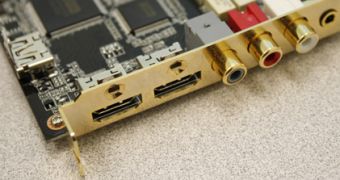Taiwanese PC vendor Asustek has just announced a new soundcard offering that promises to be more than even audio specialist Creative can carry. This might be the end of Creative's domination on the professional audio market, after long years it has ruled it with its top soundcard offerings.
The upcoming Asus Xonar DX is a feature-rich HTPC sound card that will connect to the computer via a PCI-Express x1 expansion slot. The card will come stripped off its aluminum EM shielding that "adorned" the previous Xonar D2 and D2X cards, but will ship with gold-plated half-height and full-height Brackets. Given the fact that the card will be seated on a less-powerful CPI-Express x1 card, the additional power requirements will be satisfied by a 4-pin molex floppy connector. The Asus Xonar DX card is currently Dolby Digital Live and DTS Connect certified, and it is likely that it will come with THX certification too.
Asus is also working on another nifty soundcard product that is known as the Xonar AV1. The card will act like a fundamental layer for all the upcoming sound products in the Xonar family and comes packed with a plethora of new and interesting features. The AV1 version is full of surprises, and the greatest of all is the huge number of connectors that makes even an audio enthusiast drop its jaw with amazement.
The Xonar AV1 goes way beyond the consumer market, and can easily satisfy a large number of professionals. It comes in two "chapters", namely the Xonar AV1 main card, and the HDAV-DB1 daughterboard that will feature no less than 10 different connectors, including an insane number of three HDMI input/output ports.
The Asus Xonar AV1 will also solve the problem of HDMI-enabled camcorders that cannot be used at their peak capabilities because there is no HDMI-enabled soundcard until now. However, there is no word on HDMI-In and HDMI-Out implementations in the Xonar D3X consumer-oriented cards.
The price is still undisclosed, but it will depend on the final features implemented in the daughterboard.

 14 DAY TRIAL //
14 DAY TRIAL //